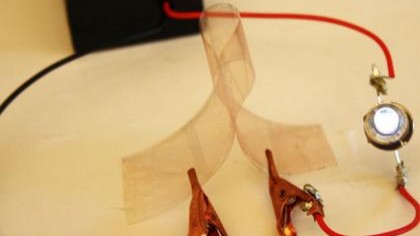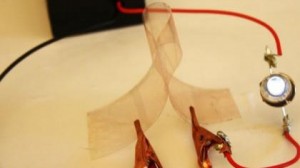In June of last year we reported on the success by researchers at Duke University in developing a technique capable of producing copper nanowires at a scale that could make them a potential replacement for rare and expensive indium tin oxide (ITO) in touch screens and solar panels. However, the water-based production process resulted in the copper nanowires clumping, which reduced their transparency and prevented the copper from oxidizing, thereby decreasing their conductivity. The researchers have now solved the clumping problem and say that copper nanowires could be appearing in cheaper touch screens, solar cells and flexible electronics in the next few years.

Back in 2010, when Benjamin Wiley, an assistant professor of chemistry at Duke University developed the water-based copper nanowire production process with his students, PhD candidate Aaron Rathmell and undergraduate Stephen Bergin, he said that once the clumping problem was solved, he believed the conductivity of the copper nanowires would match that of ITO and silver nanowires – an also expensive alternative to ITO. That belief appears to have now been borne out with a new technique that eliminates the clumping problem resulting in copper nanowire films that have the same properties as those currently used in electronic devices and solar cells.
The new technique organizes copper atoms in water to form long, thin, “non-clumped” nanowires that are then transformed into transparent conductive films and coated onto glass or plastic substrates. Unlike ITO films, which are generally created using a slow and expensive vapor disposition process, the copper nanowires could be coated in a roll-to-roll process as the new technique is water-based and the copper nanowires are flexible.
This flexibility also means copper nanowires could be used to build flexible electronics – another advantage over ITO films, which are fragile and lack flexibility. Whereas ITO films’ structure break after just a few bends, the copper nanowires maintain their conductivity and form when bent back and forth 1,000 times.
But it’s cost where the big gains lie. Indium is a rare earth element, costing as much as US$800 a kilogram, while the silver used to create inks containing silver nanowires that can serve as an alternative to ITO costs around $1,400 per kilogram. Compare this to copper, which costs around $9 a kilogram and it’s easy to see why Wiley says the copper nanowires are a natural choice for use in the next generation of displays and solar cells.
Wiley says that, with continuing development, copper nanowires could be in screens and solar cells in the next few years, which could lead to lighter and more reliable displays and make solar energy more competitive with fossil fuels. He co-founded a company called NanoForge Corp in 2010 to manufacture copper wires for commercial purposes. The company received a US$45,000 North Carolina IDEA grant earlier this year for the refinement and scaling up of the manufacturing process of copper nanowires and is now filling orders.

 Follow
Follow